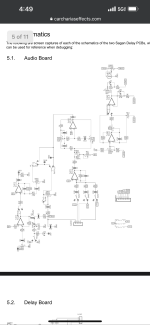You are using an out of date browser. It may not display this or other websites correctly.
You should upgrade or use an alternative browser.
You should upgrade or use an alternative browser.
Sagan delay power pin continuity question
- Thread starter Raspymcnasty
- Start date
Hard to read, but one of them seems to be labelled LGND and the other GND. That suggests to me that they are both grounds with the LGND being a ground with a particular purpose (for example it is quite common in digital circuits to have a digital ground and analog ground that are only connected at a single point to try and make sure digital clock noise doesn't get into the analog pathways). In the end though, all ground paths will be connected at some point. I would expect that LGND and GND should indeed be shorted together.
Bricksnbeatles
Member known well
I’ve seen quite a few circuits though with an analog ground and digital ground, where there aren’t directly shorted together, and are instead joined by an extremely small resistor between 10-50 Ω, leaving the potential of the analog ground a few μV over digital ground. I’ll see if I can find an example of what I meanHard to read, but one of them seems to be labelled LGND and the other GND. That suggests to me that they are both grounds with the LGND being a ground with a particular purpose (for example it is quite common in digital circuits to have a digital ground and analog ground that are only connected at a single point to try and make sure digital clock noise doesn't get into the analog pathways). In the end though, all ground paths will be connected at some point. I would expect that LGND and GND should indeed be shorted together.
Raspymcnasty
Active member
Thank you for your response! This answers my question and follow up question.I’ve seen quite a few circuits though with an analog ground and digital ground, where there aren’t directly shorted together, and are instead joined by an extremely small resistor between 10-50 Ω, leaving the potential of the analog ground a few μV over digital ground. I’ll see if I can find an example of what I mean
Raspymcnasty
Active member
Perfect thank you!Hard to read, but one of them seems to be labelled LGND and the other GND. That suggests to me that they are both grounds with the LGND being a ground with a particular purpose (for example it is quite common in digital circuits to have a digital ground and analog ground that are only connected at a single point to try and make sure digital clock noise doesn't get into the analog pathways). In the end though, all ground paths will be connected at some point. I would expect that LGND and GND should indeed be shorted together.

